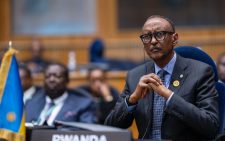Finally, harvest season brings relief from food crisis

After bountiful rains and the Government making subsidised fertilizer widely available countrywide, food has started coming in from farms as Kenyans harvest.
Food crops that had been out of reach due to the high cost as a result of shortages have now flooded markets, and homes are now having a wide choice of cheaply available food. From potatoes to beans to tomatoes to all manner of greens, milk and fruits, the food landscape in Kenya has drastically changed. Prices have tumbled, literally.
This is good news to a country that started the year with high prices of food, serious shortages, and the lingering effects of a devastating drought that had put at least half of the country’s population at risk of starvation.
With a bumper harvest of maize expected in the next two months, the price of maize flour, that has resisted all attempts at bringing down, will finally be tamed by maize which will be available from the farms at much lower than the current levels.
Of course, nothing is more critical than food adequacy. The threat of famine and people dying from starvation completely distracts a government from other pursuits. You cannot pretend to be building roads and bridges when your people are dying of starvation.
The Government must now ensure a structured way of ensuring food adequacy . While this connotes food that is priced affordably, it is equally an imperative for food security that farmers make handsome returns from farming, so that they remain forever motivated to return for the next season.
The Government must manage postharvest trading of food. The much touted guaranteed minimum returns must be put in place. Either that or subsidise inputs to a level that enables farmers to grow food at costs below selling price. Farmers must never make a loss from their produce. This calls for an elaborate storage network for farmers across the country.
The warehousing system that has for some reason never taken off, must now be fully implemented. This enables farmers to store their produce during the glut period immediately after harvest, and release it depending on how favourable the prices in the market are.
This will necessarily mean that farm inputs must be made cheap and readily available. The bumper harvest being seen across the country is an indication that subsidised fertilisers, which the Government made available, had a major impact on yields and readiness of farmers to till the land.
Never again should the country’s strategic grain reserve be empty. Kenya is now a country in permanent crisis mode over food security. One failed season, and all hell breaks loose. Food prices escalate, entire counties are faced with starvation, and the Government must mobilise billions of shillings by diverting funds from other programmes to import food.
The strategic reserve was created to stabilise the country’s food stocks in case of crop failure. The Government must start buying grain from farmers to start the process of building up these reserves. Such reserves will also be used to stabilise grain prices by releasing into the market stocks when prices start spiking due to low availability.
More land must be put under agriculture. Food is serious business, and Kenya’s economy rises and ebbs depending on how its agriculture is doing. The Agriculture Finance Corporation must be revamped and recapitalised to enable it finance farmers across the country. No farmer should be unable to plant in the farming season because they lacked money for labour or inputs.
And lastly, the Government must, for once, be serious about irrigation. With the 100 dams promised by the Kenya Kwanza administration, Kenya can become a net exporter of food in the next two years.
— gathukara@gmail.com












